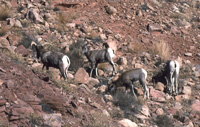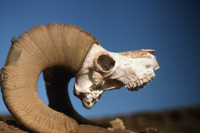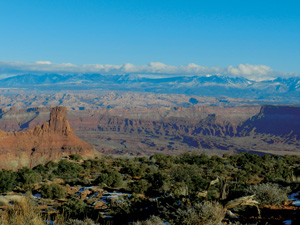Winter Bighorns |
||||
January can be a quiet time in the canyons. At times, winter snows blanket the slickrock creating a special serenity.
 Cold temperatures drive away visitors and even the locals. For the wildlife in Canyon Country, January marks the transition toward the promise of spring. Cold temperatures drive away visitors and even the locals. For the wildlife in Canyon Country, January marks the transition toward the promise of spring. Until that promise comes true, winter is a great time to watch for wildlife. Deep snow pushes the deer and elk out of the mountains and into the foothills. Birds of prey seem to adorn each elevated perch, and even the predators become prey to wintertime conditions. Of all the wildlife in the Canyon Lands, I think a winter sighting of desert bighorns is an exceptional treat.  During the time of the Ancestral Puebloans, desert bighorns were plentiful. Images carved in stone or painted on canyon walls reflect this abundance. The prehistoric natives hunted the sheep for meat and hides, but also made tools from the bones and horns. During the time of the Ancestral Puebloans, desert bighorns were plentiful. Images carved in stone or painted on canyon walls reflect this abundance. The prehistoric natives hunted the sheep for meat and hides, but also made tools from the bones and horns.After the native people migrated from the region, bighorn sheep populations endured. For several hundred years, the bighorns had only to contend with predators and injuries. When settlers and explorers began to filter into the region, bighorn populations began to decline from hunting pressure and diseases carried by livestock.  When Canyonlands National Park became established in 1964, bighorn sheep numbers were estimated to be in the hundreds. A far cry from the populations Father Escalante described during the Dominquez-Escalante expedition through the area in 1776, “…through here wild sheep live in such abundance that their tracks are like those of great herds of domestic sheep.” In the 1980s, bighorn sheep captured in the Island in the Sky District of Canyonlands National Park and relocated to Arches National Park. After a health inspection by a veterinarian, some of the sheep were fitted with radio collars to track their post-release movements. Since that initial relocation, there have been others within the state. Building up a viable herd is a time-consuming process, one that is marked with successes and failures. Therefore, every bighorn sighting is a special one. Here are several locations where bighorns may be observed from paved roads.  1. Highway 128, AKA the River Road, from Moab upstream along the Colorado River to Dewey Bridge. Look for sheep from the safety of pullouts between Negro Bill Canyon and Salt Creek on the Arches side of the river. 1. Highway 128, AKA the River Road, from Moab upstream along the Colorado River to Dewey Bridge. Look for sheep from the safety of pullouts between Negro Bill Canyon and Salt Creek on the Arches side of the river.2. Arches National Park boundary along Highway 191. From the Colorado River Bridge up to the park’s entrance, look for sheep in the grasslands on the Arches side. 3. Dead Horse Point State Park. One of my favorite observation places is to walk the rim trail back to the east and scan for sheep far below with binoculars. 4. Long Canyon. Depending upon the road conditions, this dirt road off of the Potash Road can provide some great views. Just remember to view these magnificent animals from a safe distance, and to minimize disturbances that might spook the sheep. Keep an ear out for small rockfalls, indicators that sheep may be moving across a slope. Remember that patience may pay off in spades, as the bighorns do not betray their presence easily.
|

 2012 is here and many people are making their New Year resolutions. Perhaps it’s to lose some holiday weight, or to clean and organize the garage. What better way to start off the New Year than making a pledge to revisit the places we’ve long ago checked off our list. Taking another visit to one of Moab’s parks might change our entire memory of the place. Visitors to Dead Horse Point often visit with limited time and are only able to see what can be reached by car. Very few visitors spend the day and venture farther than the famous view of the gooseneck bend in the Colorado River.
2012 is here and many people are making their New Year resolutions. Perhaps it’s to lose some holiday weight, or to clean and organize the garage. What better way to start off the New Year than making a pledge to revisit the places we’ve long ago checked off our list. Taking another visit to one of Moab’s parks might change our entire memory of the place. Visitors to Dead Horse Point often visit with limited time and are only able to see what can be reached by car. Very few visitors spend the day and venture farther than the famous view of the gooseneck bend in the Colorado River.